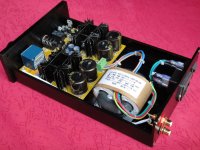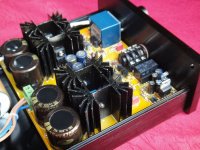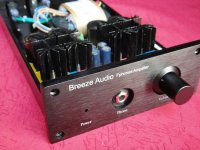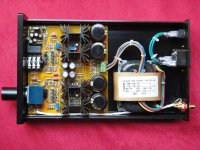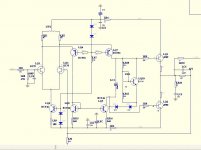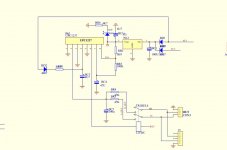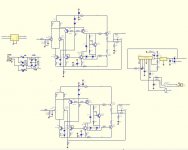Hello all,
I design three headphone amps: E3, E4, E5
E4 is the upgrade version of E3, E5 is the upgrade version of E4, E5 sounds more pure and natural. And better performance in the heat sink and protection.
They own different characteristics. (E3 refer to the beyerdynamic A1 headphone, E4 refer to the JC2 dual differential FET input construction, E5 using Marantz HDAM input structure)
Some audiophiles in my domestic discuss these headphone amps, they like the E5 best.
Here are the pictures of E5 headphone amp, work on class A.
I design three headphone amps: E3, E4, E5
E4 is the upgrade version of E3, E5 is the upgrade version of E4, E5 sounds more pure and natural. And better performance in the heat sink and protection.
They own different characteristics. (E3 refer to the beyerdynamic A1 headphone, E4 refer to the JC2 dual differential FET input construction, E5 using Marantz HDAM input structure)
Some audiophiles in my domestic discuss these headphone amps, they like the E5 best.
Here are the pictures of E5 headphone amp, work on class A.
Attachments
Don't like the look of this one. 
Firstly, it's clearly not a Class A amplifier, it actually uses a Class AB output stage, it may use a heavy class A bias, but it still isn't a class A amp.
It also looks like you are going to have some real stability issues here because you aren't compensating for the dominant pole by using a frequency compensation cap in the voltage amplification stage. Judging by the combination of transistors that you have used its a nearly dead cert that this amp is going to oscillate.
Why would you use an LED string in series with the Vbe multiplier to set the bias current , it's completely unnecessary and pointless and a much better solution (in terms of thermal stability) can be found by simply changing the resistor values of the Vbe multiplier.
, it's completely unnecessary and pointless and a much better solution (in terms of thermal stability) can be found by simply changing the resistor values of the Vbe multiplier.
Also, why the need for the 75 ohm output resistor? It ruins the damping factor and means you have to increase the closed loop gain, resulting in more distortion.
It ruins the damping factor and means you have to increase the closed loop gain, resulting in more distortion.
Firstly, it's clearly not a Class A amplifier, it actually uses a Class AB output stage, it may use a heavy class A bias, but it still isn't a class A amp.
It also looks like you are going to have some real stability issues here because you aren't compensating for the dominant pole by using a frequency compensation cap in the voltage amplification stage. Judging by the combination of transistors that you have used its a nearly dead cert that this amp is going to oscillate.
Why would you use an LED string in series with the Vbe multiplier to set the bias current
Also, why the need for the 75 ohm output resistor?
 It ruins the damping factor and means you have to increase the closed loop gain, resulting in more distortion.
It ruins the damping factor and means you have to increase the closed loop gain, resulting in more distortion.Well I now have one, one issue with making any comparison is that I simply don't have anything to compare it to, besides my laptop soundcard.
I am letting it run on the bench for a few days, with some older fisher-price headphones, just in case something goes awry.
So far it has DC offset of 25, and 27 mv, and appears stable in that respect.
Will have to wait for Santa to deliver some better headphones in order to really check it out...
Also have a DAC in the same chassis to confuse things further; Coaxial DIR9001 WM8740DAC Decoders USB Coaxial G 1 | eBay
I am letting it run on the bench for a few days, with some older fisher-price headphones, just in case something goes awry.
So far it has DC offset of 25, and 27 mv, and appears stable in that respect.
Will have to wait for Santa to deliver some better headphones in order to really check it out...
Also have a DAC in the same chassis to confuse things further; Coaxial DIR9001 WM8740DAC Decoders USB Coaxial G 1 | eBay
Well, I don't know which component is contributing what to the overall sound, but it sounds great, no complaints, plenty of headroom, very gradual breakup.
The heatsinks are warm, can't be too much over 100 farenheit though, my experience has told me that 135 is about the max you can stand to touch for any amount of time, and these are nowhere near that.
There is 18, and 21 mv of dc coming through at idle.
I might swap the opa275 out for a dual opa627au on the DAC, but that can wait.
I ran the output through my home stereo, an SAE2300, and some old Dahlquist speakers, and it sounded very good.
Couldn't really ask for much more, considering the usb source, and of course, the price!
This isn't an end all setup, is for work to drown out the ambient noise so I can work, and not get fatigued by my setup.
The heatsinks are warm, can't be too much over 100 farenheit though, my experience has told me that 135 is about the max you can stand to touch for any amount of time, and these are nowhere near that.
There is 18, and 21 mv of dc coming through at idle.
I might swap the opa275 out for a dual opa627au on the DAC, but that can wait.
I ran the output through my home stereo, an SAE2300, and some old Dahlquist speakers, and it sounded very good.
Couldn't really ask for much more, considering the usb source, and of course, the price!
This isn't an end all setup, is for work to drown out the ambient noise so I can work, and not get fatigued by my setup.
After having good luck with my own e5, I suggested it to a friend, however when we powered it up either LR1, or LR2 on one channel became very hot. I yanked the power cord before the little 47 ohm resistor actually flamed, but it's now reading 3.3 ohms after that.
I'm headed down to radio shack to find a replacement resistor, but I'm also wondering where to look for the root cause? Any guesses?
My variable bench ps has taken a time out it seems also, not a great day for electronics tinkering so far anyways...
I'm headed down to radio shack to find a replacement resistor, but I'm also wondering where to look for the root cause? Any guesses?
My variable bench ps has taken a time out it seems also, not a great day for electronics tinkering so far anyways...
You didn't do something stupid like reversing the supply voltages by any chance? Either that, or the corresponding cascode transistor is dead short or something. Double check that transistors are installed correctly (orientation and type).
I have never heard of a burnt resistor with less than its specified value btw.
I have never heard of a burnt resistor with less than its specified value btw.
You didn't do something stupid like reversing the supply voltages by any chance? Either that, or the corresponding cascode transistor is dead short or something. Double check that transistors are installed correctly (orientation and type).
I have never heard of a burnt resistor with less than its specified value btw.
respected "childish mistakes" I do not,,, I wanted to find out from the developer resistor value
That did strike me as odd, regarding the resulting ohms.
The transistor wasn't mated correctly to the heat sink, and after removing some other components, I was able to massage it into a position where it will no longer have an air gap behind it!
After driving to a nearby town, I have source the correct resistor, and after replacing it have noticed a crackly sound from that channel. If my friend or myself hadn't waited over a year to try this thing out, maybe would consider a return. The shipping from China would probably make it a wash however...
The transistor wasn't mated correctly to the heat sink, and after removing some other components, I was able to massage it into a position where it will no longer have an air gap behind it!
After driving to a nearby town, I have source the correct resistor, and after replacing it have noticed a crackly sound from that channel. If my friend or myself hadn't waited over a year to try this thing out, maybe would consider a return. The shipping from China would probably make it a wash however...
All problems are solved. But it took a substantial revision of the amplifier. Were replaced all the transistors on and 2SK2240 2SA970 with selection in pairs and sets. As well have been replaced by the output transistors on 2SK2013 and 2SJ313 selected from the slope of the characteristics of up to 2%. After this, the sound gained magical lightness and razreshenie.Ya satisfied..
I’ve just spent a little time with the non-performing E5 board from back in 2014.
A loose joint was repaired, and now all is well.
My friend had went and purchased another board in the event that the first one wasn’t easily repaired. I don’t think he’s interested in corded headphones now, so I have these two additional boards in the event my work setup wears out. A good day for sure.
A loose joint was repaired, and now all is well.
My friend had went and purchased another board in the event that the first one wasn’t easily repaired. I don’t think he’s interested in corded headphones now, so I have these two additional boards in the event my work setup wears out. A good day for sure.
Does anyone have an idea of options for output replacements for this circuit?
Amp still plays, but I suspect the hfe is down.
A recent bad experience involving a closed cabinet and amp accidentally left on for a week unattended has created a need
Teach me to take a vacation…
Amp still plays, but I suspect the hfe is down.
A recent bad experience involving a closed cabinet and amp accidentally left on for a week unattended has created a need
Teach me to take a vacation…
- Home
- Amplifiers
- Headphone Systems
- My E5 Class A hifi headphone amp
